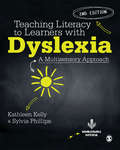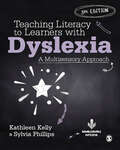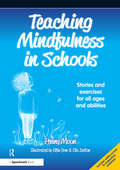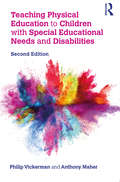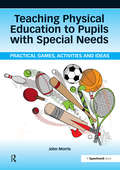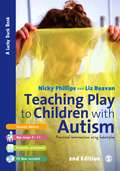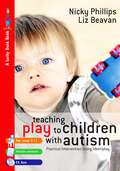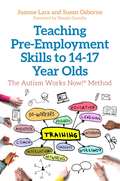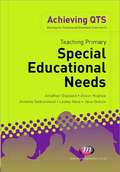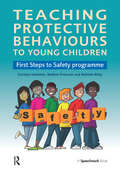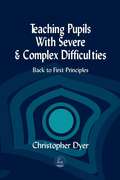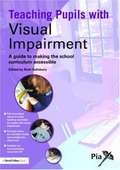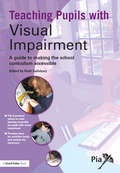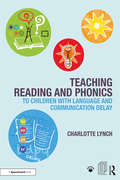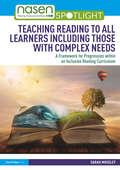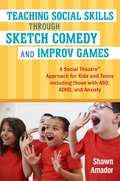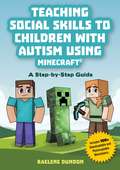- Table View
- List View
Teaching Literacy to Learners with Dyslexia: A Multi-sensory Approach
by Kathleen Kelly Sylvia PhillipsThe Second Edition of this bestselling book provides a structured multi-sensory programme for teaching literacy to children and young people from 5-18 with dyslexia and other specific literacy difficulties. Supported by a wealth of resources available online and updated throughout, the new edition now includes a brand new section on Implementing the Accelerated Programme for learners who have already acquired some literacy skills. This includes: A placement test to indicate whether the programme is appropriate A diagnostic assessment procedure to determine where the learner should begin on the Accelerated Programme Examples of lesson plans, reading cards and spelling cards to help teachers prepare resources for their students With tried and tested strategies and activities this book continues to provide everything you need to help improve and develop the literacy skills of learners in your setting including; the rationale for a structured multi-sensory approach the development of phonological, reading, writing and spelling skills working with learners who have English as an Additional Language (EAL) lesson structure and lesson-planning alphabet and dictionary skills memory work and study skills teaching the programme to groups ideas for working with young children.
Teaching Literacy to Learners with Dyslexia: A Multi-sensory Approach
by Kathleen Kelly Sylvia PhillipsThe Second Edition of this bestselling book provides a structured multi-sensory programme for teaching literacy to children and young people from 5-18 with dyslexia and other specific literacy difficulties. Supported by a wealth of resources available online and updated throughout, the new edition now includes a brand new section on Implementing the Accelerated Programme for learners who have already acquired some literacy skills. This includes: A placement test to indicate whether the programme is appropriate A diagnostic assessment procedure to determine where the learner should begin on the Accelerated Programme Examples of lesson plans, reading cards and spelling cards to help teachers prepare resources for their students With tried and tested strategies and activities this book continues to provide everything you need to help improve and develop the literacy skills of learners in your setting including; the rationale for a structured multi-sensory approach the development of phonological, reading, writing and spelling skills working with learners who have English as an Additional Language (EAL) lesson structure and lesson-planning alphabet and dictionary skills memory work and study skills teaching the programme to groups ideas for working with young children.
Teaching Literacy to Learners with Dyslexia: A Multisensory Approach
by Kathleen Kelly Sylvia PhillipsThis bestselling book for teaching literacy to children and young people aged 4–16 years with dyslexia and other specific literacy difficulties has been fully updated for its third edition. Providing a structured multi-sensory programme, ‘Conquering Literacy’, that includes placement tests, well-established strategies and examples of lesson planning, teaching activities, and reading, spelling and literacy concept cards, this book is an essential practical resource for teachers. This new edition includes: an additional section for learners who need an individualised, structured programme at an advanced stage (Stage II); a section on planning shorter, targeted interventions for learners with a particular difficulty e.g. spelling, revising; three new chapters on teaching reading, spelling and writing within mainstream classrooms using strategies which are successful with learners with dyslexia downloadable teaching resources available from the companion website.
Teaching Literacy to Learners with Dyslexia: A Multisensory Approach
by Kathleen Kelly Sylvia PhillipsThis bestselling book for teaching literacy to children and young people aged 4–16 years with dyslexia and other specific literacy difficulties has been fully updated for its third edition. Providing a structured multi-sensory programme, ‘Conquering Literacy’, that includes placement tests, well-established strategies and examples of lesson planning, teaching activities, and reading, spelling and literacy concept cards, this book is an essential practical resource for teachers. This new edition includes: an additional section for learners who need an individualised, structured programme at an advanced stage (Stage II); a section on planning shorter, targeted interventions for learners with a particular difficulty e.g. spelling, revising; three new chapters on teaching reading, spelling and writing within mainstream classrooms using strategies which are successful with learners with dyslexia downloadable teaching resources available from the companion website.
Teaching Literacy to Learners with Dyslexia: A Multisensory Approach
by Kathleen Kelly Sylvia PhillipsThis bestselling book for teaching literacy to children and young people aged 4–16 years with dyslexia and other specific literacy difficulties has been fully updated for its third edition. Providing a structured multi-sensory programme, ‘Conquering Literacy’, that includes placement tests, well-established strategies and examples of lesson planning, teaching activities, and reading, spelling and literacy concept cards, this book is an essential practical resource for teachers. This new edition includes: an additional section for learners who need an individualised, structured programme at an advanced stage (Stage II); a section on planning shorter, targeted interventions for learners with a particular difficulty e.g. spelling, revising; three new chapters on teaching reading, spelling and writing within mainstream classrooms using strategies which are successful with learners with dyslexia downloadable teaching resources available from the companion website.
Teaching Mindfulness in Schools: Stories and Exercises for All Ages and Abilities
by Penny MoonTeaching Mindfulness in Schools is a practical teaching toolkit for educators and all professionals concerned with the social and emotional wellbeing of children. The book offers clear introductions to the many aspects and benefits of mindfulness for young people, as well as a wealth of practical guidance and tools to support the teaching of mindfulness in the classroom. Key features include: a range of stimulus materials including artwork and poems to read one-on-one with a child or for whole-class teaching; lesson plans, worksheets and colouring sheets to support a huge range of activity types including physical, creative and sensory exercises so that there is material to suit all the children you work with; audio recordings of guided mindfulness exercises for use in the classroom, narrated by the author and available to purchasers via the Speechmark website. Penny Moon is the founder of A Quiet Place, with nearly three decades of experience in workshop facilitation, teaching, emotional and behaviour development, psychotherapy, complimentary medicine, educational therapeutics and child, parent and family support.
Teaching Physical Education to Children with Special Educational Needs and Disabilities
by Philip Vickerman Anthony MaherTeaching Physical Education to Children with Special Educational Needs and Disabilities provides a thorough overview of the challenges and opportunities for inclusion in PE lessons. Combining a theoretical framework with practical strategies for teachers, the title covers a diverse range of issues which teachers need to address to provide high quality learning experiences for children with SEND. This second edition is grounded in up-to-date research on inclusion and has been fully updated in line with the SEND Code of Practice and Ofsted Inspection Framework. It seeks to demystify the statutory responsibilities placed upon teachers and schools to include children with SEND and offers practical examples of how PE teachers can make use of different strategies to differentiate through their planning and assessment. A new chapter explores the importance of consulting with and empowering children with SEND, and additional focus is given to how teachers can work together with SENCOs and LSAs to develop an inclusive culture in PE lessons. Written in an accessible style with reflective tasks in each chapter, this unique text clearly outlines relevant practice-based evidence to fully include children with SEND in PE lessons. This will be essential reading for teachers and school leaders and will enable PE teachers to plan and deliver inclusive lessons for all children.
Teaching Physical Education to Children with Special Educational Needs and Disabilities
by Philip Vickerman Anthony MaherTeaching Physical Education to Children with Special Educational Needs and Disabilities provides a thorough overview of the challenges and opportunities for inclusion in PE lessons. Combining a theoretical framework with practical strategies for teachers, the title covers a diverse range of issues which teachers need to address to provide high quality learning experiences for children with SEND. This second edition is grounded in up-to-date research on inclusion and has been fully updated in line with the SEND Code of Practice and Ofsted Inspection Framework. It seeks to demystify the statutory responsibilities placed upon teachers and schools to include children with SEND and offers practical examples of how PE teachers can make use of different strategies to differentiate through their planning and assessment. A new chapter explores the importance of consulting with and empowering children with SEND, and additional focus is given to how teachers can work together with SENCOs and LSAs to develop an inclusive culture in PE lessons. Written in an accessible style with reflective tasks in each chapter, this unique text clearly outlines relevant practice-based evidence to fully include children with SEND in PE lessons. This will be essential reading for teachers and school leaders and will enable PE teachers to plan and deliver inclusive lessons for all children.
Teaching Physical Education to Pupils with Special Needs
by John MorrisTeaching Physical Education to Pupils with Special Needs. Practical Games Activities and Ideas John Morris Physical education is paramount to the holistic development of every young person. More so when that young person has physical, cognitive, and or emotional /behavioural difficulties to overcome also. Teaching physical education to children with special needs often requires the teacher or coach to use different methods and approaches in order to generate even the smallest improvement in learning, performance, and independence. The activities games and adaptations featured in the book have been developed within the teaching environment and enable students with special needs to have opportunities to participate and compete whilst learning and consolidating new and existing skills. Activities in the book can be used to supplement existing programs and schemes of work or they can be used as stand alone activities. They are intended and designed to be inclusive also. The contents have been organised into sections that cover: games and ball skills; gymnastics and dance; developing spatial awareness and Athletic activities; and schemes of work influenced by the national curriculum and the equals' schemes have been supplied to use with the activities so that the book provides a user with a guide for how to deliver an adapted PE program to pupils with special needs. They may also be useful to mainstream teachers who may need to supplement and adapt mainstream PE programs to accommodate pupils with moderate learning difficulties or physical disabilities. It covers A4, Wire-0-bound 98 pp.
Teaching Play to Children with Autism: Practical Interventions using Identiplay
by Liz Beavan Nicky PhillipsThe Identiplay intervention helps children on the autistic spectrum, and those with specific communication disorders, learn to play. Through the use of play scripts the approach promotes the development of social skills, understanding, imagination and exploration. By learning these skills the young person can enjoy reciprocal play with an adult or peer. Supported by case studies the theory behind the approach is fully outlined and scripts are provided for instant use in a number of settings. The new edition of this popular book includes: - More on developing your own scripts - How to assess the child's current play skills - The adult's role in play - The use of visual/verbal support - New case studies - New scripts - Advice on taking learning outdoors - Links to resources and useful websites A supporting CD ROM contains video clips of the intervention in practice, printable scripts and a PowerPoint presentation to facilitate professional training making this a vital resource for anyone working with young children on the autistic spectrum or with communication difficulties.
Teaching Play to Children with Autism: Practical Interventions Using Identiplay
by Liz Beavan Nicky PhillipsFor children on the autistic spectrum and those with a specific communication disorder the social and emotional impairment demonstrates itself in, amongst other ways, a difficulty in learning to play and a resulting isolation from peers and their imaginative and physical world. The authors explain the function and development of play for children who develop the skills normally. Their analysis has provided a sound theoretical basis for the practical teaching programme which promotes the development and opportunity to practise the elements: " social skills and social understanding, " imagination, " rehearsal, " flexibility and change, " exploration. The sections of the book cover: 1. Tabletop Identiplay - instructions on how to set up this positive and practical play intervention based on the work of Beyer and Gammeltoft 2. Identiplay kits and play scripts - a resource bank of copiable pages clearly listing ideas for Identiplay kits and possible play scripts to use with each set. 3. Beyond Identiplay - ways of adapting Identiplay to further extend play skills, moving away from the original format of a table-top activity, and applying the principles in a wider range of activities, such as role play, the development of leisure activities, water play, and outdoor games. A CD-ROM is included containing the photographs, video clips and scripts to allow printing of all the materials.
Teaching Pre-Employment Skills to 14–17-Year-Olds: The Autism Works Now!® Method
by Joanne Lara Susan Osborne Temple GrandinBased on the Autism Works Now!® Workplace Readiness Workshop, this interactive resource shows how to help students aged 14-17 develop the necessary transition skills for getting and keeping a meaningful job, with accompanying worksheets available to download. Structured around 2-hour weekly sessions over an eight month period, the program is ideal for teaching to groups of students with autism. It covers essential topics such as organization and time management, interview skills, appropriate workplace attire, and networking. It advises on how to arrange a field trip to local businesses so students can gain experience of being in the workplace. Worksheets and questionnaires help to track progress and discover what types of job will be appropriate based on an individual's skills and interests, and the book also includes a template for creating effective resumes.
Teaching Pre-Employment Skills to 14–17-Year-Olds: The Autism Works Now!® Method (PDF)
by Joanne Lara Susan Osborne Temple GrandinBased on the Autism Works Now!® Workplace Readiness Workshop, this interactive resource shows how to help students aged 14-17 develop the necessary transition skills for getting and keeping a meaningful job, with accompanying worksheets available to download. Structured around 2-hour weekly sessions over an eight month period, the program is ideal for teaching to groups of students with autism. It covers essential topics such as organization and time management, interview skills, appropriate workplace attire, and networking. It advises on how to arrange a field trip to local businesses so students can gain experience of being in the workplace. Worksheets and questionnaires help to track progress and discover what types of job will be appropriate based on an individual's skills and interests, and the book also includes a template for creating effective resumes.
Teaching Primary Special Educational Needs
by Jonathan Glazzard Alison Hughes Annette Netherwood Lesley Neve Jane StokoeToday, there is increased emphasis on the coverage of special educational needs in initial teacher training. This comprehensive introduction begins by looking at inclusion policy and how barriers to achievement can be removed. The SEN Code of Conduct is explained and detailed guidance on Individual Education Plans (IEPs) is included. The book then goes on to give practical advice on the teaching of children with special educational needs in reading, speech and language, the autistic spectrum and behavioural, social and emotional difficulties. Finally, the book considers the wider context looking at partnerships with parents, carers and professionals in other agencies.
Teaching Protective Behaviours to Young Children: First Steps to Safety Programme
by Carolyn Gelenter Belinda RileyThis programme aims to provide children aged 4-7 years with awareness and strategies for keeping safe. Although it may be difficult to accept, children and young people from any community, including those with disabilities, can be put at risk of harm, abused or hurt, regardless of their age, gender, religion or ethnicity. All children have the right to be safeguarded from abuse or neglect so they have the opportunity to reach their potential and be successful adults. Protective behaviours teaches children to develop an awareness of personal safety; helps them to identify and express their feelings; make choices and solve problems. First Steps to Safety has taken the core protective behaviour principles and created a teaching framework with overarching aims, with supporting lesson plans, resources and activities, in a 10 week programme that can be picked up and used by anyone in school wanting to empower children and young people of any age and any capability to develop personal safety. The information and strategies provided to children are generic and applicable across a range of situations that may arise, for example bullying, internet safety, being harmed, feeling sad or feeling unsafe. Sessions include: my body parts; showing my feelings; my body, thoughts and feelings all go together; feeling safe; behaviour choices; to empower children to feel safe and know they have a right to fee safe; to give children the confidence and ability to assertively manage their own safety; to children the skills to take responsibility for their own bodies, thoughts, feelings and behaviour; to enable children with a range of communication abilities to ask for help; for children to have awareness of their body, thoughts, feelings and behaviour; have a vocabulary to express how their thoughts and feelings affect their bodies; know the early warning signs for feeling unsafe; know they can make different behaviour choices based on feelings; and know who good people are to go to for help and how to ask for help.
Teaching Pupils with Severe and Complex Difficulties: Back to First Principles (PDF)
by Christopher DyerShortlisted for Special Educational Needs Book Award 2001 In response to the growing demand for fully inclusive education, this book explores the principles that should guide teachers in meeting the educational needs of pupils with severe learning difficulties and relates these to effective classroom approaches. It examines the special needs of pupils with severe learning difficulties from the inside out, so that teachers understand the 'why' as well as the 'how' of education. It also examines issues of behaviour and punishment, offering positive and appropriate methods of dealing with classroom disruption. Christopher Dyer returns to first principles to show that the basics of teaching and education remain constant, no matter what the difficulties of the individual pupil might be, and that these basic principles are vital to planning IEPs (Individual Education Programmes). In an educational system increasingly made up of schemes, targets and progress reports, this book is a much-needed guide to finding and stimulating the learning potential of every child.
Teaching Pupils With Visual Impairment: a Guide to Making the School Curriculum Accessible
by Ruth SalisburyBursting with practical advice, suggestions and handy tips, providing readers with a positive starting point for sharing ideas and good practice, this is a key practical guide to making learning accessible for primary and secondary school pupils with visual impairment. This user-friendly book shows how, with appropriate support, pupils with visual impairment in mainstream schools can have as rewarding an experience of education as their sighted peers. The majority of contributors are qualified teachers for visual impairment, with many years' experience working with pupils in a variety of settings. Covering the curriculum and each subject area in detail, Teaching Pupils with Visual Impairment includes guidance on: activities within and outside the classroom making the school's physical environment accessible inclusion within the school's social environment. Teachers and support staff will have immediate access to a wealth of ideas, supported by invaluable resources on the accompanying CD/website, including a complete electronic version of the book in large print, allowing older pupils to take a more active role in the learning process.nbsp;
Teaching Pupils with Visual Impairment: A Guide to Making the School Curriculum Accessible (Access and Achievement)
by Ruth SalisburyBursting with practical advice, suggestions and handy tips, providing readers with a positive starting point for sharing ideas and good practice, this is a key practical guide to making learning accessible for primary and secondary school pupils with visual impairment. This user-friendly book shows how, with appropriate support, pupils with visual impairment in mainstream schools can have as rewarding an experience of education as their sighted peers. The majority of contributors are qualified teachers for visual impairment, with many years' experience working with pupils in a variety of settings. Covering the curriculum and each subject area in detail, Teaching Pupils with Visual Impairment includes guidance on: activities within and outside the classroom making the school's physical environment accessible inclusion within the school's social environment. Teachers and support staff will have immediate access to a wealth of ideas, supported by invaluable resources on the accompanying CD/website, including a complete electronic version of the book in large print, allowing older pupils to take a more active role in the learning process.
Teaching Pupils with Visual Impairment: A Guide to Making the School Curriculum Accessible (Access and Achievement)
by Ruth SalisburyBursting with practical advice, suggestions and handy tips, providing readers with a positive starting point for sharing ideas and good practice, this is a key practical guide to making learning accessible for primary and secondary school pupils with visual impairment. This user-friendly book shows how, with appropriate support, pupils with visual impairment in mainstream schools can have as rewarding an experience of education as their sighted peers. The majority of contributors are qualified teachers for visual impairment, with many years' experience working with pupils in a variety of settings. Covering the curriculum and each subject area in detail, Teaching Pupils with Visual Impairment includes guidance on: activities within and outside the classroom making the school's physical environment accessible inclusion within the school's social environment. Teachers and support staff will have immediate access to a wealth of ideas, supported by invaluable resources on the accompanying CD/website, including a complete electronic version of the book in large print, allowing older pupils to take a more active role in the learning process.
Teaching Reading and Phonics to Children with Language and Communication Delay
by Charlotte LynchTeaching Reading and Phonics to Children with Language and Communication Delay is an accessible and jargon-free book full of practical ideas for teaching the first stages of reading and phonics to children who have speech and language delay. Written by a bestselling author, this invaluable toolkit covers approaches to the teaching of reading for a variety of needs so that no child is left behind. Features include: • a wide range of practical activities • useful checklists at the end of each chapter for assessing progress and further planning • links to example photo books to demonstrate how reading can be personalised and interactive • tips for teaching reading and motivating children in their learning • template material which can be photocopied and downloaded as eResources Packed with helpful illustrations and examples that can be used in lessons, this book offers a variety of methods of teaching reading, including an emphasis on visual strategies which are well suited to children with language delay and complex communication needs. Clear explanations and step-by-step instructions mean the book can be used by parents as well as non-specialist teachers and teaching assistants, and the book will be ideal reading for any educators working with young children to improve their literacy.
Teaching Reading to All Learners Including Those with Complex Needs: A Framework for Progression within an Inclusive Reading Curriculum (nasen spotlight)
by Sarah MoseleyLearning to read and having access to a rich reading curriculum has a huge impact upon us both emotionally and academically. so how can we ensure that it is seen as an entitlement of all learners, including those defined as having profound and multiple learning difficulties (PMLD) and the most complex needs? This accessible book provides professionals with the knowledge and confidence to develop reading for all learners. It integrates the latest ideas and research into a practical framework to create an inclusive reading curriculum and support learners across the whole education spectrum, including those with the most complex needs. Each chapter includes a mixture of research, strategies, and case study examples, demonstrating how reading supports both wellbeing and access to learning and - with stories - provides a versatile vehicle to build on vocabulary and expand our ability to think and learn about our place in the world. Teaching Reading to All Learners Including Those with Complex Needs is essential reading for both new and experienced teachers and special educational needs and disabilities coordinators (SENDCo)s looking to develop an inclusive reading curriculum and culture which will positively impact on the outcomes of all young people.
Teaching Reading to All Learners Including Those with Complex Needs: A Framework for Progression within an Inclusive Reading Curriculum (nasen spotlight)
by Sarah MoseleyLearning to read and having access to a rich reading curriculum has a huge impact upon us both emotionally and academically. so how can we ensure that it is seen as an entitlement of all learners, including those defined as having profound and multiple learning difficulties (PMLD) and the most complex needs? This accessible book provides professionals with the knowledge and confidence to develop reading for all learners. It integrates the latest ideas and research into a practical framework to create an inclusive reading curriculum and support learners across the whole education spectrum, including those with the most complex needs. Each chapter includes a mixture of research, strategies, and case study examples, demonstrating how reading supports both wellbeing and access to learning and - with stories - provides a versatile vehicle to build on vocabulary and expand our ability to think and learn about our place in the world. Teaching Reading to All Learners Including Those with Complex Needs is essential reading for both new and experienced teachers and special educational needs and disabilities coordinators (SENDCo)s looking to develop an inclusive reading curriculum and culture which will positively impact on the outcomes of all young people.
Teaching Social Skills Through Sketch Comedy and Improv Games: A Social Theatre™ Approach for Kids and Teens including those with ASD, ADHD, and Anxiety
by Shawn AmadorIntroducing a Social Theatre™, this book provides guidance on how to deliver fun and transformative activities to develop social skills in teenagers and children. Drawing on ideas from Social Thinking®, CBT, mindfulness and assertiveness training this book develops games, skits and short plays which can be adapted to suit children and teenagers including those who are gifted, typical, and those with mild to moderate cognitive abilities. These activities will help participants become more assertive and flexible as well as improving confidence, focus and self-esteem. Social Theatre™ can be used in small groups, in class or throughout the school, as well as in group therapy sessions. It provides a new and inclusive way to teach social skills and collaborative learning and is especially useful for those with anxiety, ADHD and ASD.
Teaching Social Skills Through Sketch Comedy and Improv Games: A Social Theatre® Approach For Kids And Teens Including Those With Asd, Adhd, And Anxiety
by Shawn AmadorIntroducing a Social Theatre™, this book provides guidance on how to deliver fun and transformative activities to develop social skills in teenagers and children. Drawing on ideas from Social Thinking®, CBT, mindfulness and assertiveness training this book develops games, skits and short plays which can be adapted to suit children and teenagers including those who are gifted, typical, and those with mild to moderate cognitive abilities. These activities will help participants become more assertive and flexible as well as improving confidence, focus and self-esteem. Social Theatre™ can be used in small groups, in class or throughout the school, as well as in group therapy sessions. It provides a new and inclusive way to teach social skills and collaborative learning and is especially useful for those with anxiety, ADHD and ASD.
Teaching Social Skills to Children with Autism Using Minecraft®: A Step by Step Guide
by Raelene Dundon Chloe-Amber ScottThis comprehensive and accessible guide contains everything that needs to be known in order to set up and run a Minecraft® Social Group for children with autism spectrum disorders.Minecraft®, often described as 'digital Lego', provides an ideal forum to help children with autism and related conditions to develop social and communication skills. This book offers guidance on how to use the game to support the learning of social and emotional concepts such as having a conversation, showing interest in others and understanding another person's point of view.With over 150 pages of photocopiable and downloadable session plans, visuals and handouts, this manual is essential reading for professionals working with autism who are interested in introducing Minecraft® to support social skill development in their students.
